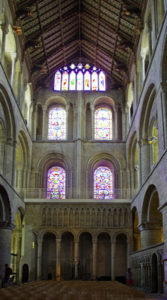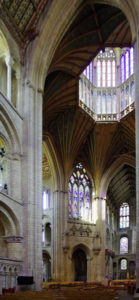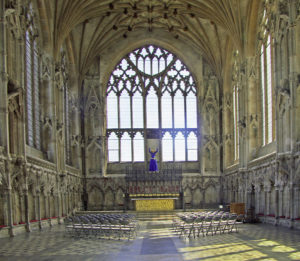Entry is through the splendid Gothic Galilee Chapel built onto the west end of the Cathedral. The arcading on the inside walls is particularly fine with the double row of offset columns.
The arches above the double doors are beautifully carved and the oak door is covered with decorative scrollwork.
On the north wall of the west tower is the Millennium sculpture of The Way of Life, with the cross at the end of a winding path. Looking up to the top of the west tower, it has a beautifully painted ceiling with Christ in Majesty.
The south west transept is a wonderful example of Norman architecture which was sympathetically restored by Gilbert Scott in the C19th. It is now the Baptistry with a C19th font. Again it has a wonderful painted ceiling, best seen from the “Stained Glass Museum”:http://wasleys.org.uk/eleanor/churches/england/cambridgeshire/ely/ely_ten/index.html in the south west triforioum.
Off the transept is St Catherine’s Chapel, which is reserved for private prayer.
The nave really does have the WOW factor with its three rows of round arches soaring to the ceiling. It is breathtaking with its Norman architecture and painted ceiling. It is also very long, reflecting the power and importance of the newly arrived Normans. This must rank as one of the best cathedrals in the country.
The ceiling panels tell the story of the ancestry of Christ, beginning with Adam and Eve, continuing through Abraham, Jacob and David, to the Annunciation, Nativity, Adoration of the Magi and ending with Christ in Majesty. The detail can be seen better from the Stained Glass Museum in the south east triforium, although not all of the panels can be seen.
The side aisles have vaulted stone ceilings and blind Norman arcading along the walls.
The Prior’s Door on the south wall dates from around 1135. The South door by the south transept leads into the remains of the cloisters and has a beautifully carved outside.
Near the Prior’s door is the Saxon Ovin’s Stone, which is the base of a wayside cross from a nearby village. The Latin inscription translates as ‘Give o God to Ovin your light and rest. Amen
Tombs along the side aisles reflect the changing styles of architecture from the early C17th tomb of dean Henry Caesar, to the simple memorial to the early C18th Bishop William Fleetwoord to the Victorian Gothic style of C19th Bishop James Russell with its iron railings.
The transepts lead off the crossing beneath the Octagon and are part of the Norman cathedral, built around 1090. They have classic Norman arcading around the walls. The top windows were replaced when the C15th painted hammer beam ceilings was added. This has winged angels along the base.
Off the south transept is the Chapel of St Dunstan and St Ethelwold, who were refounded the Benedictine Monastery in Ely after Viking raids in the C9th.
St Edmund’s Chapel off the North transept has the remain of C14th Wall paintings, the only ones to survive in Ely. They originally showed scenes from the life of St Edmund, but only his martyrdom at the top of the north wall can be seen clearly. It shows him tied to a tree before being shot by arrows. Below, the wall is painted to imitate cloth wall hangings with stripes on the north wall and circles on the south wall.
Next to it is St George’s Chapel, which is the Cambridgeshire Regimental Chapel, dedicated to those who died in both world wars. Their names are written on a series of hinged oak panels.
The Lady Chapel is reached either from the north Transept or the recently built Processional Way from the north Choir Aisle, restoring the route used by Medieval pilgrims. The Lady Chapel was built in the mid C14th and is a wonderful example of the Decorated style architecture.
The first impression on entering is its size. It is BIG and is the largest and most elaborate of any British cathedral. There are no chairs making it feel even larger. Light streams in through the large plain glass windows. Round the base of the walls is elaborately carved arcading. Statues were either removed or their heads defaced during the Reformation. The walls would originally have been brightly painted and remains of this can still be seen, especially behind the altar. The Millennium statue of the Blessed Virgin Mary above the altar is the only splash of colour now. The altar and metal reredos were installed in 2011.
There is more information and pictures “here.”:http://wasleys.org.uk/eleanor/churches/england/cambridgeshire/ely/index.html










